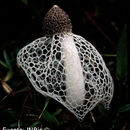Phallus indusiatus (früher Dictyophora indusiata) ist eine Pilzart aus der Gattung der Stinkmorcheln.
Merkmale
Makroskopische Merkmale
Das 15 bis 25 mm durchmessende Hexenei ist kugelförmig bis umgekehrt eiförmig (obovoid) und gelblich weiß bis bräunlich weiß gefärbt. Das zylindrische, unpigmentierte, schwammige Receptaculum erreicht eine Länge von 100 bis 150 mm und einen Durchmesser von 10 bis 30 mm. Der Hut (das Käppchen) ist glockenförmig, durch Falten an der Oberfläche netzig-wabig strukturiert und an der Spitze durchlöchert. Die Gleba ist braun, schleimig und übelriechend. Das von der Unterseite des Hutes herabhängende, netzförmige Indusium ist gut entwickelt, weiß bis blass gelb und erreicht eine Länge von etwa 3/4 der Länge des Receptaculums.[1][2]
Mikroskopische Eigenschaften
Die elliptischen Sporen sind glatt, farblos und 2,5 bis 4 μm lang und 1 bis 2 μm breit.[1][2]
Vorkommen
Die Art Phallus indusiatus kommt in den Tropen vor, einschließlich Afrika (Kongo,[3] Nigeria,[4] Uganda[5] und Zaire[6]), Südamerika (Brasilien[7] Guyana,[8] und Venezuela[9]), Zentralamerika (Costa Rica)[10] und Tobago.[11] In Nordamerika kommt sie nur in Mexiko vor.[12] Asiatische Standorte sind Indonesien, Malaysia,[13] Indien,[14] Südchina, Japan[15] und Taiwan.[16] Sie wurde auch in Australien gefunden.[17]
Ökologie
Der Pilz wächst sowohl auf sandigen und fruchtbaren Böden sowie auf pflanzlichem Material. In Indien wächst er am besten bei Temperaturen zwischen 21 und 25 °C mit 45–85 % relativer Luftfeuchtigkeit in Bambusdickicht in Höhen von 300 – 600 m.[18] Die Art ist saprobiont.
![src=]()
Phallus indusiatus, ohne Hütchen (Kappe) getrocknet
Nutzung
Phallus indusiatus ist essbar und ein Bestandteil der gehobenen chinesischen Küche. Die Art wird kommerziell angebaut und ist häufig auf asiatischen Märkten zu finden. Diese Stinkmorchel ist reich an Proteinen, Kohlenhydraten und Ballaststoffen. Sie enthält bioaktive Verbindungen, ist antioxidativ und antimikrobiell.[19] Ihr Einsatz in China zur Behandlung entzündlicher Magen- und Nervenerkrankungen ist seit 618 n. Chr. nachgewiesen.[18]
Einzelnachweise
-
↑ a b Altielys Casale Magnago, Larissa Trierveiler-Pereira, Maria Alice Neves: Phallales (Agaricomycetes, Fungi) from the tropical Atlantic Forest of Brazil. In: Journal of the Torrey Botanical Society 140(2), 2013, S. 236–244. (Online)
-
↑ a b Iuri Baseia, Leonor Maia, Francisco Diego Calonge: Notes on Phallales in the neotropics. In: Boletín de la Sociedad Micologica de Madrid 30, 2006, S. 87–93. (Online)
-
↑ H. Dissing, M. Lange: Gasteromycetes of Cong. Bulletin du Jardin botanique de l'État à Bruxelles, 32 (4), 1962, S. 325–416. doi:10.2307/3667249.
-
↑ S. G. Jonathan, A. C. Odebode, D. D. S. Bawo: Studies on collection and proximate compositions of Phallus indusiatus (Vent. ex. Pers), a Nigerian higher fungus. World Journal of Agricultural Sciences, 4 (1), 2008, S. 18–22.
-
↑ T. D. Maitland, E. M. Wakefield: Notes on Uganda fungi. I.: The fungus-flora of the forests. Bulletin of Miscellaneous Information (Royal Gardens, Kew), 1917 (1), S. 1–19, doi:10.2307/4113409.
-
↑ V. Demoulin, D. M. Dring: Gasteromycetes of Kivu (Zaire), Rwanda and Burundi. Bulletin du Jardin botanique national de Belgique / Bulletin van de National Plantentuin van België. 45 (3/4), 1975, S. 339–372, doi:10.2307/3667488.
-
↑ L. Trierveiler-Pereira, A. C. Gomes-Silva, I. G: Baseia: Notes on gasteroid fungi of the Brazilian Amazon rainforest. Mycotaxon, 2009, 110: S. 73–80, doi:10.5248/110.73.
-
↑ E. Wakefield: Contributions to the flora of tropical America: XXI. Fungi collected in British Guiana, chiefly by the Oxford University Expedition, 1929. Bulletin of Miscellaneous Information (Royal Gardens, Kew). 1934 (6), S. 238–258, doi:10.2307/4115405.
-
↑ R. W. G. Dennis: Fungi venezuelani: III. Kew Bulletin, 14 (3), 1960, S. 418–458, doi:10.2307/4114758.
-
↑ J. A. Sáenz, M. Nassar: Hongos de Costa Rica: Familias Phallaceae y Clathraceae. Revista de Biologia Tropical, 30 (1), 1982, S. 41–52.
-
↑ R. W. G. Dennis: Some West Indian Gasteromycetes. Kew Bulletin, 8 (3), 1953, S. 307–328, doi:10.2307/4115517.
-
↑ G. Guzmán: Some distributional relationships between Mexican and United States mycofloras. Mycologia, 65 (6), 1973, S. 1319–1330, doi:10.2307/3758146.
-
↑ S. G. Oldridge, D. N. Pegler, D. A. Reid, B. M. Spooner: A collection of fungi from Pahang and Negeri Sembilan (Malaysia). Kew Bulletin, 41 (4), 1986, S. 855–872, doi:10.2307/4102987.
-
↑ C. G. Lloyd: Synopsis of the known phalloids. Bulletin of the Lloyd Library of Botany, Pharmacy and Materia Medica, (13), 1909, S. 1–96.
-
↑ N. Tuno: Spore dispersal of Dictyophora fungi (Phallaceae) by flies. Ecological Research, 13 (1), 1998, S. 7–15, doi:10.1046/j.1440-1703.1998.00241.x.
-
↑ T. T. Chang, W. N. Chou, S. H. Wu: 福山森林之大型擔子菌資源及監測種之族群變動 [Inventory of macrobasidiomycota and population dynamics of some monitored species at Fushan forest]. Fungal Science (in Chinese), 15 (1/2), 2000, S. 15–26.
-
↑ K. N. Smith: A Field Guide to the Fungi of Australia. UNSW Press, Sydney 2005, S. 200.
-
↑ a b Phallus indusiatus bei Malaysia Biodiversity Information System (MyBIS)
-
↑ C. Mohanan: Biodiversity of Terricolous and Lignicolous Macrofungi of the Western Ghats. 2011, Kerala Forest Research Institute, herausgegeben vom MoEF, Government of India, New Delhi. S. 91. (Online)


